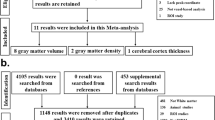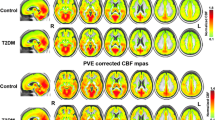Abstract
Introduction
Type 2 diabetes (DM2) is associated with cognitive decline, but the pathogenesis of this important complication remains unclear. We investigated whether abnormalities in neuronal metabolism or membrane integrity in normal appearing cerebral white matter are associated with cognitive impairment in patients with DM2.
Methods
Single voxel proton magnetic resonance spectroscopy (1.5 T), aimed at N-acetyl-aspartate (NAA), total choline (Cho), and total creatine (Cr), was performed in the cerebral white matter (centrum semiovale) of 72 patients with DM2 and 40 control subjects. All participants underwent extensive neuropsychological evaluation.
Results
Patients with DM2 performed worse with respect to global neuropsychological functioning than controls (p < 0.05), in particular on memory and information processing speed. We observed no differences in NAA/Cr, Cho/Cr, or NAA/Cho ratio’s between patients with DM2 and controls. Cognitive performance in patients with DM2 was not correlated with any of these brain metabolites, neither were the clinical variables.
Conclusion
We conclude that disturbances in neuronal viability and cellular membrane status assessed by NAA/Cr, Cho/Cr, NAA/Cho ratios cannot explain cognitive decline in patients with DM2.

Similar content being viewed by others
References
Stewart R, Liolitsa D (1999) Type 2 diabetes mellitus, cognitive impairment and dementia. Diabet Med 16:93–112
Allen KV, Frier BM, Strachan MW (2004) The relationship between type 2 diabetes and cognitive dysfunction: longitudinal studies and their methodological limitations. Eur J Pharmacol 490:169–175
van Harten B, de Leeuw FE, Weinstein HC, Scheltens P, Biessels GJ (2006) Brain imaging in patients with diabetes: a systematic review. Diabetes Care 29:2539–2548
Di MU, Morano S, Valle E, Pozzessere G (1995) Electrophysiological alterations of the central nervous system in diabetes mellitus. Diabetes Metab Rev 11:259–277
Lackovic Z, Salkovic M, Kuci Z, Relja M (1990) Effect of long-lasting diabetes mellitus on rat and human brain monoamines. J Neurochem 54:143–147
Manschot SM, Brands AM, van der Grond J, Kessels RP, Algra A, Kappelle LJ, Biessels GJ (2006) Brain magnetic resonance imaging correlates of impaired cognition in patients with type 2 diabetes. Diabetes 55:1106–1113
Williams SR (1992) In vivo proton spectroscopy: experimental aspects and potential. In: Rudin M (ed) NMR basic principles and progress. Springer, Berlin, pp 55–71
Kantarci K, Jack CR Jr, Xu YC, Campeau NG, O’Brien PC, Smith GE, Ivnik RJ, Boeve BF, Kokmen E, Tangalos EG, Petersen RC (2000) Regional metabolic patterns in mild cognitive impairment and Alzheimer’s disease: a 1H MRS study. Neurology 55:210–217
Parnetti L, Tarducci R, Presciutti O, Lowenthal DT, Pippi M, Palumbo B, Gobbi G, Pelliccioli GP, Senin U (1997) Proton magnetic resonance spectroscopy can differentiate Alzheimer’s disease from normal aging. Mech Ageing Dev 97:9–14
Catani M, Cherubini A, Howard R, Tarducci R, Pelliccioli GP, Piccirilli M, Gobbi G, Senin U, Mecocci P (2001) (1)H-MR spectroscopy differentiates mild cognitive impairment from normal brain aging. NeuroReport 12:2315–2317
Metastasio A, Rinaldi P, Tarducci R, Mariani E, Feliziani FT, Cherubini A, Pelliccioli GP, Gobbi G, Senin U, Mecocci P (2006) Conversion of MCI to dementia: role of proton magnetic resonance spectroscopy. Neurobiol Aging 27:926–932
Ajilore O, Haroon E, Kumaran S, Darwin C, Binesh N, Mintz J, Miller J, Thomas MA, Kumar A (2007) Measurement of brain metabolites in patients with type 2 diabetes and major depression using proton magnetic resonance spectroscopy. Neuropsychopharmacology 32:1224–1231
Geissler A, Frund R, Scholmerich J, Feuerbach S, Zietz B (2003) Alterations of cerebral metabolism in patients with diabetes mellitus studied by proton magnetic resonance spectroscopy. Exp Clin Endocrinol Diabetes 111:421–427
Kario K, Ishikawa J, Hoshide S, Matsui Y, Morinari M, Eguchi K, Ishikawa S, Shimada K (2005) Diabetic brain damage in hypertension: role of renin-angiotensin system. Hypertension 45:887–893
Kreis R, Ross BD (1992) Cerebral metabolic disturbances in patients with subacute and chronic diabetes mellitus: detection with proton MR spectroscopy. Radiology 184:123–130
Modi S, Bhattacharya M, Sekhri T, Rana P, Tripathi RP, Khushu S (2008) Assessment of the metabolic profile in type 2 diabetes mellitus and hypothyroidism through proton MR spectroscopy. Magn Reson Imaging 26:420–425
Sahin I, Alkan A, Keskin L, Cikim A, Karakas HM, Firat AK, Sigirci A (2008) Evaluation of in vivo cerebral metabolism on proton magnetic resonance spectroscopy in patients with impaired glucose tolerance and type 2 diabetes mellitus. J Diabetes its Complications 22:254–260
Klein R, Klein BE, Magli YL, Brothers RJ, Meuer SM, Moss SE, Davis MD (1986) An alternative method of grading diabetic retinopathy. Ophthalmology 93:1183–1187
Bril V, Perkins BA (2002) Validation of the Toronto Clinical Scoring System for diabetic polyneuropathy. Diabetes Care 25:2048–2052
Anbeek P, Vincken KL, van Bochove GS, van Osch MJ, van der Grond J (2005) Probabilistic segmentation of brain tissue in MR imaging. Neuroimage 27:795–804
Bottomley PA (1987) Spatial localization in NMR spectroscopy in vivo. Ann N Y Acad Sci 508:333–348
van den Boogaart A (1997) A user’s guide to the magnetic resonance user interface software package. Delft Technical University Press, Delft
Lezak MD, Howieson DB, Loring DW (2004). Neuropsychological Assessment (4th ed.). New York: Oxford University press
Bright P, Jaldow E, Kopelman MD (2002) The national adult reading test as a measure of premorbid intelligence: a comparison with estimates derived from demographic variables. J Int Neuropsychol Soc 8:847–854
Conflict of interest statement
We declare that we have no conflict of interest.
Author information
Authors and Affiliations
Corresponding author
Additional information
Sadly, after submission of this paper, Marc Pleizier has deceased.
Rights and permissions
About this article
Cite this article
Tiehuis, A., van der Meer, F., Mali, W. et al. MR spectroscopy of cerebral white matter in type 2 diabetes; no association with clinical variables and cognitive performance. Neuroradiology 52, 155–161 (2010). https://doi.org/10.1007/s00234-009-0598-4
Received:
Accepted:
Published:
Issue Date:
DOI: https://doi.org/10.1007/s00234-009-0598-4




